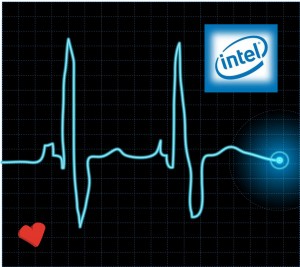By David Tran on October 10th, 2012
Intel has just acquired biometrics company IDesia, a medical devices company based out of Israel for several million dollars. IDesia develops heart-based biometric technology that authenticates users by using electrical signals generated by the heartbeat and allows computers, mobile phones, gadgets and electronic devices to recognize these heartbeat signals. The company previously raised $7 million from Partech International and Aladdin Knowledge Systems which is now a unit of SafeNet. Gidi Barak, Chairman of IDesia, has also sold other companies to Intel. In 2004, Barak sold Envara to Intel for $40 million and in 1999 he sold DSP Communications to Intel for $1.6 billion.
Biometrics has long been used as a way to authenticate users, but there are concerns those technologies such as face recognition and fingerprint readers can be easily manipulated. Intel is hoping that monitoring heart beats is a more advanced and secure way to recognize users. IDesia uses electronic signals, also called electro biodynamic signatures, generated by the heartbeat of an individual that is unique to each person and cannot be forged. The signature is obtained through a user’s finger where electronic signals can be collected. The product requires a user’s finger and a small metal sensor which appeals to airports, border crossings and personal electronic equipment.
It is not clear yet what Intel will do with the acquisition of IDesia, but Intel already has a presence in Israel with staff and other acquisitions in the country. Last year Intel acquired Telmap for $300 million, which is an Israel location based services company and has become part of Intel’s consumer services division.
IDesia CEO, Dr. Daniel Lange will continue to serve as a consultant to Intel as IDesia’s products are integrated and stated, “Identification on the basis of heartbeat is not a biometric measurement recognized by any government body, we concentrated in recent years on sales in the consumer products sector and in this field large capital is needed to penetrate markets, and in Israel it is difficult to raise capital for an end-use electronic product.” Lange also said, “I would be happier if the company had not to be sold because in my opinion it has great potential. But as an entrepreneur the most important thing is that the technology will be brought to market, and it looks like Intel is the company that can ensure that.”
IDesia is unique and Intel may be able to use their technology to incorporate it into products such as smart phones and tablets which could monitor the heartbeats of patients as well as possibly use it to authenticate people. This biometric technology hasn’t been proven to be secure way to authenticate people yet, but the technology could be of use in the healthcare industry since it measures a user’s electronic signals.
The technology is of interest to Intel since it has a big interest in the health care industry. Intel has a joint venture with General Electric called Care Innovations to provide health care products such as tablets that are targeted at the health care industry. In addition to that, Intel is also conducting research on health care for senior citizens. With Intel having so much vested in the healthcare industry, they may use the biometric authentication technology to supplement their existing businesses or incorporate the technology in their products.
We believe that it is unlikely that the technology from IDesia will go into Intel’s next microprocessors, but Intel has already a team of developers in Israel that might find a use for it. The Intel team in Israel was responsible for the architecture behind the Core and Core 2 microprocessors.
If Intel uses the IDesia technology to create innovative ways to monitor patient’s heartbeats or use it in other innovative ways they may have made a good acquisition, but if they are intending to use it to authenticate patients we believe that it will be a challenge to prove that the IDesia technology is a reliable and secure authentication solution. Even if it is used to monitor heart beats of patients remotely, secure machine to machine security measures must be in place to ensure data is transmitted safely. Biometric authentication such as facial recognition, retina scanning, and fingerprint scanning has been shown to be easy to manipulate and unreliable so Intel faces challenges if it intends to use IDesia’s technology to be a leader in the authentication industry.
We believe two factor authentication using a one-time password sent to a mobile device is still the most reliable way to authenticate users and will continue to be until new ways of authenticating users are developed. Two factor authentication using one time passwords sent to mobile devices is currently used by Google, Bank of America, and Facebook. With security breaches on the rise and more companies migrating their services to the cloud, we believe that two factor authentication systems such as those offered by as DynaPass’ out of band two factor authentication using a dynamic one time password sent to a mobile device willbe effective in protecting an organizations’s sensitive information and protecting their users.


